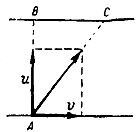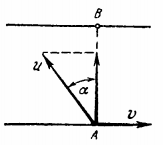Answer: l = 200m, u = 20m/min, v = 12 m/min, a = 36°52'.
Explanation:
The motion of the boat in both cases is composed of its motion relative to the water and the motion of the water relative to the shore.

First case (Fig.): The boat moves along the river with a velocity v, and when it crosses with the current, it travels a distance
l1 = vt1. (1)
The motion across the river takes place with a velocity u for a distance
l2 = ut1 (2)
Second case (Fig.): The velocity of the boat along the river is zero, i.e.

usinα = v (3)
The velocity across the river is ucosα. and the distance l2 travelled during the crossing is
l2 = (ucosα)t2. (4)
Solving equations (1), (2), (3), (4), we obtain
